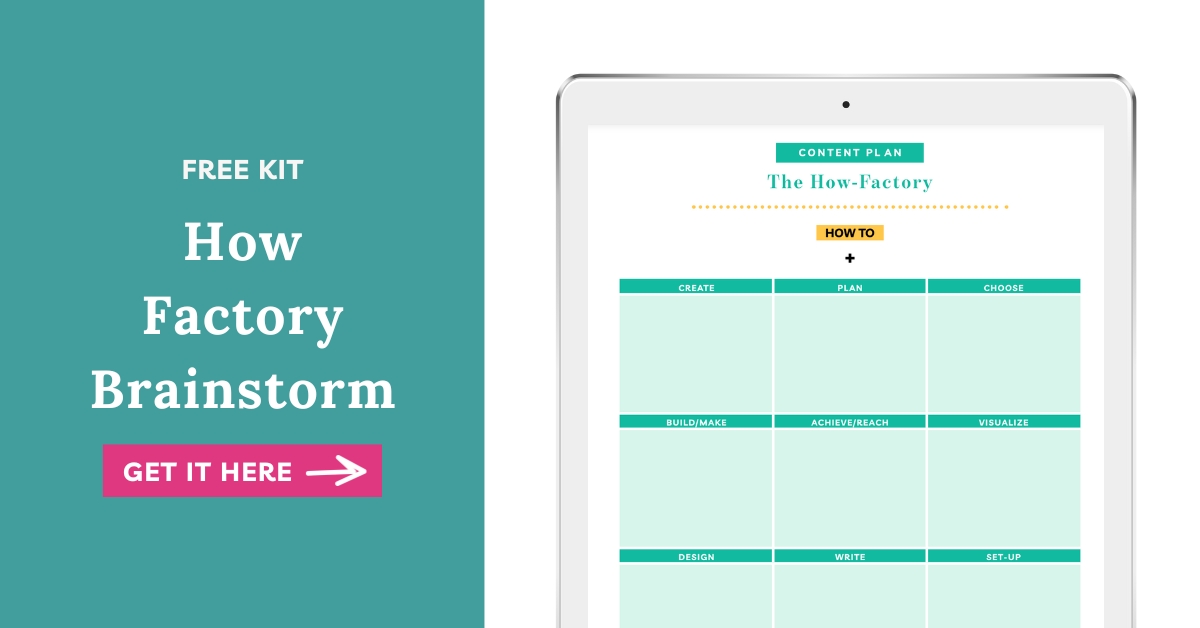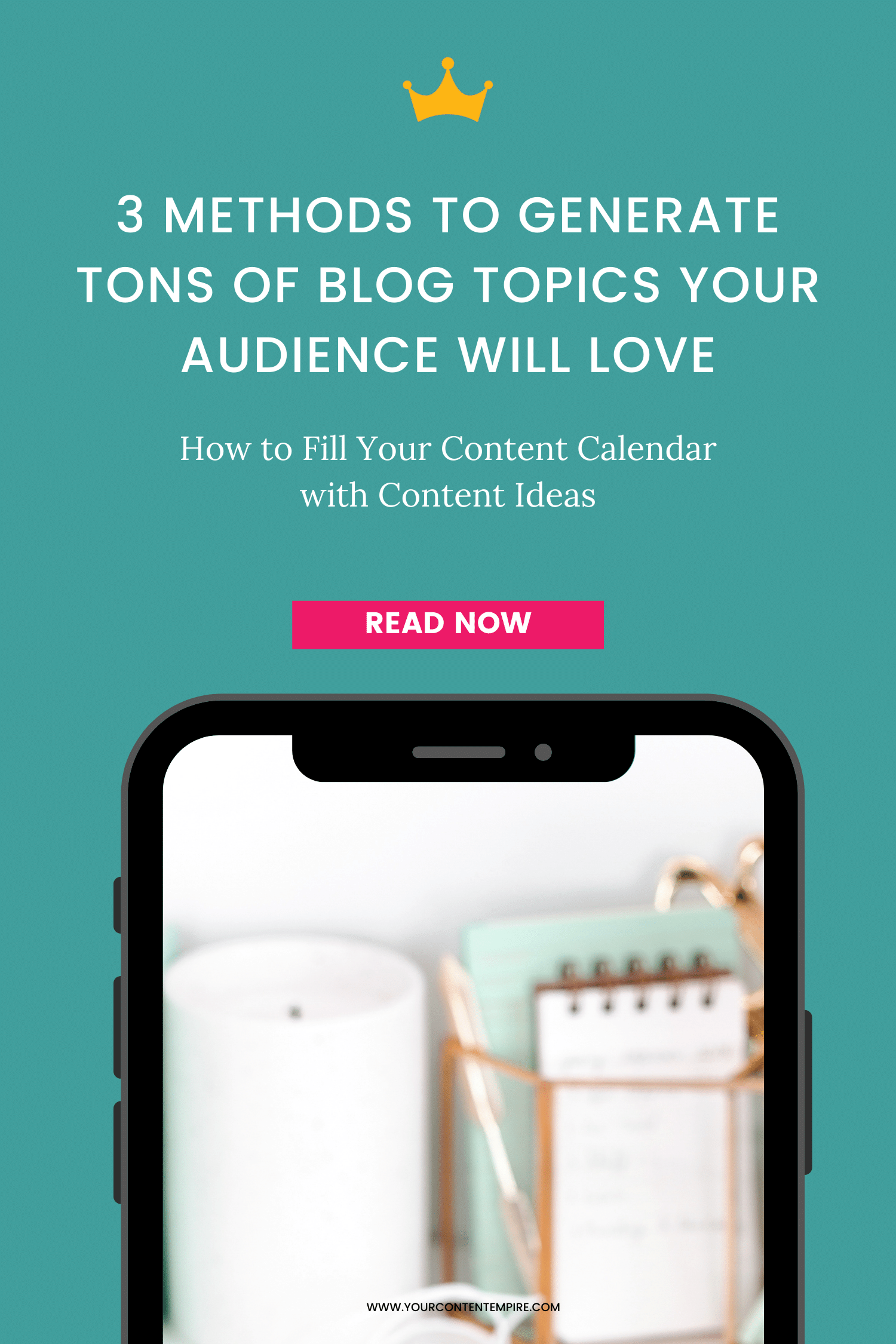
Sign up to get instant access to the How Factory!
Want more profitable + strategic content? Grab my free content planner!


I’m Hailey – content strategist and founder here at Your Content Empire where we help you create more profitable, purposeful and productive content — and hopefully enjoy yourself more while doing it too. Learn more about me here >>

Do you struggle with generating quality blog topics? Writing blogs on topics that interest you and your audience will help keep you motivated and successful.
You know what used to stop me dead in my tracks when I’d sit down and try to turn my carefully planned editorial calendar into written posts and pieces? Boring, uninspiring topics.
In a mad rush (and likely using one of those crazy ‘generate 300 blog topics in 5 minutes’ kinda prompt posts), I’d brainstorm topics and slot them into dates on my calendar. Sure they fit the bill of what my blog was about and what could interest my readers – but they'd do nothing for me when I sat down to write.
A little like Dr. Jekyll and Mr. Hyde – my right-brained, organized planning side would be satisfied, but my more creative, left-brained side that actually created the content would feel cheated and uninspired.
I learned the hard way that quality really does mean much more than quantity (unfortunately it took me several attempts before I actually learned this lesson).
Eventually, I came to the conclusion that my content would only be a success if the content fulfilled my curiosity – and as a bonus, it would help and delight my audience.
And so, after years of trial and error, I have three methods I come back to again and again when filling my client’s editorial calendars (and my own). I’ve detailed each of them below for you to experiment with to find a method that best suits your brain and preferred planning method.
In a previous post, I detailed my Minimalist Content Strategy which included this concept of capsule content. The basic premise is this: You don't need endless amounts of content as a business owner to market and sell your offers. You need fewer higher-quality posts that relate to what you're selling.
I recommend creating 12 essential posts which make up your capsule content collection around each offer that you sell in your business. These include:
Once you have these core 12 posts, you can take a break from content creation because each of these can be repurposed in dozens of different ways and shared on various platforms. If you want to learn more about the process of using the capsule content method
Want to download the capsule content topic planner? Grab your copy by signing up for the free workshop here ↓
If I were starting my business all over again, this is the method that I would want to 100% approach my content from and will do so with any of my other businesses.
The How Factory is a finish-this-sentence process that’ll help you come up with tons of high-value topic ideas for blog posts, freebies and emails (I think the record in one of the challenges I ran was close to 100 topics).
Here’s how it works: You're going to finish a sentence. For each prompt, we'll have the words “How To” plus a verb, and then you'll finish it with whatever comes to mind for you as long as it relates to your business. No editing, no filtering at this stage, just write down whatever pops up and try to get down as many ideas as possible. I recommend setting a timer for 2-3 minutes for each one of these 9 prompts.
Here are a few examples:
Sign up below for the guided version of the How-Factory workshop and template.
Step 1: Get a Piece of Paper and Grab a Timer
Get a blank piece of paper or use the template
Step 2: Set a 2-3 minute timer for each of these and write down as many ideas that come to mind:
Step 3: Create Your Short List
Once you're finished going through each of these prompts and you've spent two to three minutes on each one, I want you to go back through with a highlighter, star with your pencil, or bold the answers if you've done it in a word doc. Choose the top 10 topics that you're the most interested in creating content around.
By the end of this, you should have a slew of topics that are good and related to your industry through a shortlist of at least 10 that you're most interested in exploring. This is an exercise you can redo anytime you're feeling a little low in the topic inspiration arena.
Sign up below for the guided version of the How-Factory workshop and template.
Step 1: Start with a general list of categories that you cover.
Compare these against what you know your potential customers are interested in reading about from you to come up with 3-5 broad topics you can cover on your blog.
For example, if you’re a web designer who only does 1:1 work with clients, writing blog posts about how someone can DIY their websites, wouldn’t be the best way to go. The people who want to read those posts aren’t your potential customers. Better topic categories might be: Website Strategy (related to overall business strategy), Preparing for Your Web Project, Education about Working with Designers, Branding, etc.
Step 2: Create a mind map for each category.
Write the category in the middle of the page (or whiteboard) and add five branches: What, Why, When, Where, How. Also, add a side column for ideas that come that don’t really fit in any of these categories.
Step 3: Generate ideas based on the W parameters.
Post types that are always fun ideas? Behind-the-scenes, interviews with complementary experts, and case studies showing your latest projects or client’s successes.
Keep your best topic ideas (even the ones you’re not going to use right away) in an inspiration bank.
One of the best resources for coming up with better content topics is an inspiration bank. It'll store, track, and filter anything you find inspiring, interesting, or something you want to come back and reference.
Everyone collects inspiration, from a Facebook group post you've come across, to a pin you've saved to read later. If you're like most people, you have these tidbits of inspiration everywhere. How do you make sure that you're using that inspiration, finding it, and seeing it when you actually need it?
In this post, I walk through the process of setting up a content inspiration and ideas system. It’s an essential content system so that whenever you’re creating a new content plan or need to come up with an idea, you can consult your bank first to save time having to go through these topic brainstorming processes all over again.
It’s important to write on topics that are interesting and matter to you because you can’t expect your audience to be excited to read something you dreaded writing all the way through.
The capsule content, how factory, and mind mapping methods are all win-win strategies because they help you create valuable content for your audience while still helping to generate topics that you find interesting too.
Download the Monthly Content Planning Kit below to keep track of all your topic ideas!
Do you get excited about creating big pieces of content for your business (think courses, books, webinars, launches, digital products, sales funnels, etc.)…only to have those dreams dashed by overwhelm? With everything you’re already fitting onto an overflowing plate...
I’ve always loved to write. I’ve kept a journal ever since I was six. I have so many novels I’ve started and packed away into boxes. I even pursued my English undergraduate degree because I felt most at home reading and writing about books. It’s hardly a surprise...
You’re not an influencer. So why are you planning your content like one? I’m going to assume that because you’re watching this video, you’re interested in using content as a strategy to grow your business. But all too often, business owners find themselves...